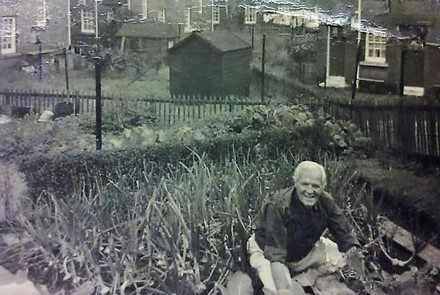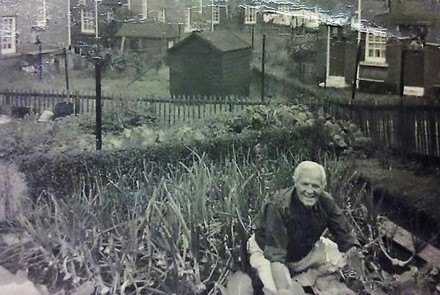ALLOTMENTS & VEGETABLE GARDENS

Twechar had a number of several allotment sites, more commonly known as ‘hen runs’, which were used to grow vegetables and fruit, and to keep chickens, and sometimes pigeons and greyhounds. These lasted until the 1980s, though one was kept until just a couple of years ago. The allotments are reported to have been things of pride, necessity and joy for the miners of the village; providing them with food in times of need and as means to enjoy the fresh air when not forced to be underground in the mines. There was also cultivation in the gardens of the mine company houses and corporation houses that were built in the early to mid-20th century. Residents, there, are said to have grown vegetables out of necessity, and grown fruit for jam and dahlias for unofficial competitions.
It is unclear, at present, who provided the allotments in Twechar or indeed, when they were established. In some cases, in Scotland, it was the mining company who provided the land and sometimes it was the local authority. There is a feeling amongst our respondents that often people just took on a piece of land and cultivated it. It can be said with certainty that the large gardens were provided by the building of new houses by Baird and Company (the local mine owners) in the 1920s and by the building of further houses by the council in the 1950s and 1960s. The following short exploration of some of the history of allotments and vegetable garden cultivation in Britain may provide some clues as to how the allotments and growing areas in Twechar came about.
Miners in Britain often moved around the country to find work and, because of this, their attitudes and motivations for keeping allotments and growing vegetables in gardens will have been shaped differently across the country. This is relevant because the allotment movements in England and Wales and those in Scotland had different beginnings and, as a result, at times their paths were dissimilar. There were, however, notable instances when these paths converged, such as during times of industrial strife and of world war.
The allotment movement in England and Wales in pre-industrial rural areas was partly shaped by the actions of the ‘Diggers’ who fought to be able to cultivate vegetables on common land just after the English Civil War and were one of the many post-land enclosure groups to fight for this down the years. Their aim was to bring about a more egalitarian system of growing and they often took over land for vegetable cultivation to this end. There were various movements towards this cause in England and Wales in the 19th century. Different laws and land rules in Scotland meant that the situation was not the same in rural areas here. Many people were brutally forced off the land and into the cities, or on to ships bound for countries such as Canada during the Highland clearances of the 18th and 19th centuries. Those who remained on the land, in other parts of Scotland, were often indentured workers and it is reported that they were invariably given ‘potato ground’ by their employers. Farmers in England were known to generally be against their labourers getting land as they thought it would distract them from their work. It is also reported that Scots had higher wages than their contemporaries in England and Wales. There were even claims that the Scots had less of a taste for self-sufficiency than those over the border and that they preferred wage labour. A House of Commons report, written in 1889, described the allotment provision in Scotland as ‘patchy and dispersed’. Because of these factors there seems to have been less of an uptake for allotment spaces in 19th century Scotland than there was south of the border.
Along with land right activism, philanthropic and reforming movements in England and Wales helped bring about the provision of allotments for workers. It was often seen as a way to keep workers out of the pub, of keeping them mentally and physically healthy, and indeed to stop them rebelling. They were less likely to get angry if they had a means to feed themselves independently of outside forces, after all. As a result, 19th century landowners and employers in England and Wales, often provided those whom they saw as ‘deserving labourers’ with allotments. There were sometimes draconian rules attached to these plots, such as a requirement for sobriety and a ban on the claiming of poor relief. There were also occasional rumblings amongst the press that the independence brought about by allotments might give the workers ‘ideas above their station’. Nevertheless, under this influence, mining companies and railway companies set up some of the earliest allotment schemes in Scotland. It is unclear whether this was the case in Twechar. Their efforts never seemed to achieve the popularity of the schemes in England and Wales. There are however, witness accounts of successful uptake of allotment schemes in certain places. It was thought that Scottish workers had better access to gardens and that mining cottages, for example, often included attached gardens. Our respondents do not think this was the case in Twechar (certainly in terms of the cultivation of vegetables), and that the only thing that was grown on the drying greens of the Twechar Rows, was the occasional patch of flowers.
Despite doubts about the population’s enthusiasm, the Allotment Act was extended by Parliament to Scotland in 1892 (having been passed in 1887 in England and Wales), and obliged local authorities to provide allotments (defined as ‘bits of land no more than forty poles or a quarter of an acre ‘in a further reforming act in 1922) for the labouring population, if 6 or more ratepayers came forward with the request. This act was brought in due to the concerns expressed by the philanthropic movement.
The uptake of allotments and growing spaces increased hugely all over Britain during World War 1, as every bit of land available was enthusiastically used by the population to grow vegetables to sustain the country when food was not getting in from abroad. There was also an increased demand for allotments by men who returned in 1918 after serving in the war. Many of these men were miners. A Royal Commission report, 1918, about the housing of the industrial population of Scotland, noted that under favourable circumstances (mentioned as proximity of plot to house, presence of a fence and long tenure) miners showed great skill and taste for gardening. It was also noted that in Mid-Lanark, the demand was rising amongst miners for allotments to work in their spare time.
The use of allotments dropped in Britain generally between the wars, as access to gardens (often modelled on allotments in size and shape) became more common. There were a couple of widespread movements to provide allotments for people who found themselves out of work in the 1920s and the 1930s. The first was the ‘Allotments for the Unemployed’ scheme which gave seeds, seed potatoes and gardening equipment to the unemployed. The Society of Friends (the Quakers) also raised public funds to buy seeds, fertiliser and tools for unemployed miners in South Wales. Both of these schemes spread countrywide and were active in Scotland. Again, this was variously seen to bring health (both mental and physical) and food to the unemployed, and as a way to prevent them from rebelling and thereby a way to prevent Bolshevism. World War 2 brought about the famous ‘Dig for Victory’ campaign, which again saw the British public turn, with vigour, to the task of growing food for the nation. They were helped by the provision of new allotments and the distribution of informational leaflets.
After the war, the popularity of allotments waned as other activities, such as going out and going on holiday, became more popular, and supermarket food became readily available. As a result, vegetable gardening did not generally appeal to the immediate post-war generation. The number of allotments in Britain also severely decreased due to land being sold off and, in the case of those near railway sidings, due to new health and safety laws. Allotments were also seen for many years after the war as the preserve of elderly gentleman and suffered from an image problem. It is unclear how many people nationwide kept on vegetable gardens in their own back yard. The fact that the short-lived, chiefly middle class ‘Goodlife’ movement of the early 1970s was seen as odd, and notable enough to make a fictional programme about, perhaps suggests there were not that many people doing this. Our respondents report that in Twechar the allotments and vegetable gardens kept going throughout this period, as a necessity for feeding families and as a much-needed way for the miners to get outdoors into the fresh air.
In the last 20 years, tending an allotment has become a hugely popular pastime in Britain. This is due to concerns about climate change, food miles and about chemical additives in food. They are also seen as ways for people to relax after working. In some parts of London, it is said that the waiting lists for allotments are 40 years long. There have also been movements such as ‘Incredible Edible’ to grow food in available spaces all over towns and villages. In the last couple of years, the people of Twechar have been developing ‘Edible Twechar’, which has seen polytunnels and raised beds set up all over the village. ‘Mr Brotherton’s Plot’ (which is the allotment that was used until a couple of years ago), is also being used as one of the training grounds for young gardeners in the village.
As has been noted, it is unclear how the allotments came to Twechar but the preceding brief look at allotment and vegetable cultivation history in Britain perhaps offers up some clues. What seems certain is that the people of Twechar still have an appreciation for the benefits of gardening and of growing their own fresh produce.
MEMORIES OF TWECHAR'S ALLOTMENTS
“Ah, the allotments in Twechar, they were massive, right along at the back of Sunnyhill. Sunnyhill there, up the top you had Burnbrae, Sunnyhill, Aniston and Windy Yetts. Down here you’d Whitelaw Terrace and here you’d Shirva Lee and then you had Merryflats and at the back of Annieston - back o’ Sunnyhill - there was old Tamson, Sneddon, Jim MacFarlane, the Kellys, they all had allotments that come doon. They wurnae easy allotments, but they were allotments, and they had chickens. they had all sorts ah fruit growing because, you know, as the sun went o’er it went right doon that bank.….and they were young men but they worked in the yard, or they worked in the pits, and when they came home from them, they wanted to go out intae the open air, and that’s where they went tae spend their time. And the allotments there was big gardens in the old NCB (National Coal Board) hooses.”
Andrew Bell
- Remembering Dad’s Allotment
Jean: “The grapevine, and that came fae one ow the places, is it Kippen? Kippen or Killin, it’s one of the villages over that way where they used tae have the largest vine in the country. And my dad knew the people over there and he got, that’s where he got his cuttings from, and grew the grapes.
Liz: The roof was covered - beautiful.
Jean: Green -you used tae watch them as they were growing, and you knew when you were able to see through them, they were ready for eating. We used to, you know, pinch a couple when he wisnae looking, and we’d blame it on the dog, you know, it was it wagging its tail that knocked them off!”
Sisters: Liz Murray and Jean Smith

